15. 02. 2022
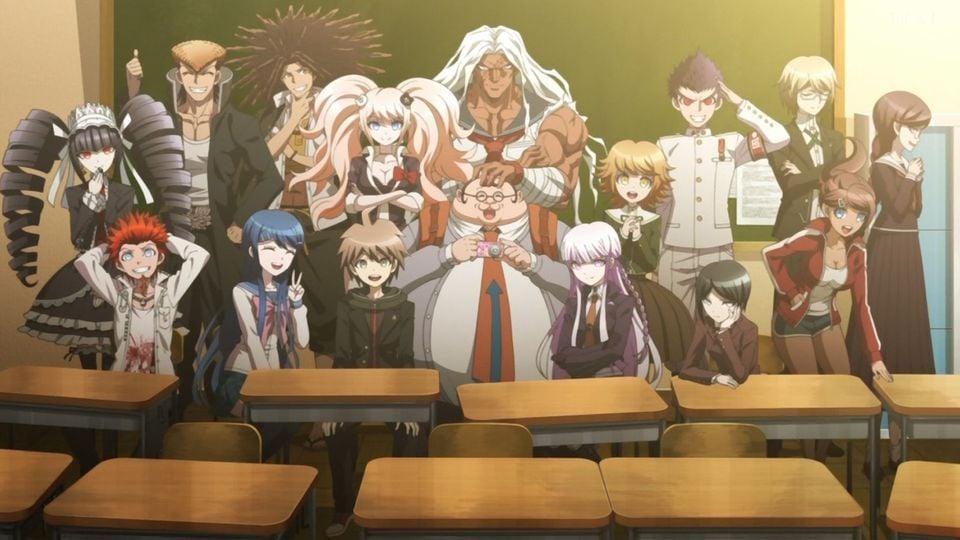
For one day a class of gifted high schoolers will wake up in their classroom with their memories erased, knowing nothing but the basic outlines of their personalities. When they try to leave, they find that the whole school is hermetically sealed off and they are thus imprisoned. Here comes the gleeful robot bear Monokuma, explaining that the ultimate talent is in KILLING GAME, from which only one student can get out.
A school can be abandoned by a student who murders another student without being caught. After each murder, there's a trial where survivors vote to guess the killer. If the vote doesn't find the killer, they're all executed, and the killer will be free to go. If the killer is caught, so is the death penalty. The only recourse for others who do not wish to murder is to condemn a sufficient number of murderers before they alone are left.
Danganronpa 1, which I mostly show here, was first published in Japan in 2010 and translated into English in 2012.
This is the - somewhat perverse - premise of three video games and anime from the Japanese series Danganronpa. If you're hearing about something like this for the first time, you're probably clutching your head, you might find it a little morally over the edge, about this kind of cruel scenario of creating a video game. More likely, this only disgusts you marginally, because you're used to something like this from the media-Squid Game, the best-known Netflix show, builds on a similar premise, and other popular video games like Fortnite or CS:GO operate on the principle of killing each other.

Instead of killing games, they're more commonly called battle royale. However, I like the designation killing games better, as it seems more accurate. I attach the list of killing games at the end.
It may surprise you, however, that the subgenre of the so-called killing games (or battle royale), in which characters are forced to kill each other against their will, is actually widespread in anime or other Korean films. A segment of the population takes this genre for about as much as the Czechs take for granted the Czech fairy tale, and they are not at all offended by the constant mutual killing, they expect it.
But what is behind the popularity of such an obscure subgenre? I'd say for it to spread like that, it has to contain some kind of statement that can touch a lot of people, tell everyone something unique. I think this statement actually contains: I would like to convince you that a properly written killing game tells us something about the world we live in. In other words, I think that in its killing game structure it responds to and criticises the social circumstances of today. As we live in an age of neoliberal capitalism, I call the genre anti-capitalist.
So in this article, we first look at how the structure of killing games actually works in an anti-capitalist way. But this only brings us to the question that prompted me to write this article: is this anti-capitalist reading still authentic? I suspect that, over time, the originally anti-capitalist motives became a genre staple and only began to repeat themselves mindlessly until they lost their edge.
You certainly don't need to have some exaggerated knowledge of killing games anime, or Asian culture, to read this article. On the contrary, with this controversy, I would like to present this genre. But at the same time, I still want to offer the genre's experts an unusual perspective and a deeper analysis.
I am writing a reader here, by which I mean a man who consumes art, whether a book, a film or a video game.
Killing games at their best contain elements of horror. This is a psychological horror film where the reader is constantly on the lookout because he doesn't know who will betray him. So the horror is both foreboding and, secondly, the very sinister situation we find ourselves in, the very thought that some external circumstance will turn normally peaceful people into murderers. Another element of horror is the more common one, where we already see a corpse or other acts of violence, and are only appalled by what we see.
As, for example, Slavoj \u017di\u017eek says in his film The perverts
In fact, the premise of Danganronpa, minus all the violence, is akin to a normal academic environment. Students have to specialise because employers require them to. They also have to present themselves as the ultimate talent and thereby overshoot their real abilities a little bit, that's just marketing. The competition for first place also tends to be a battle of all against all: when tests are written, the competition is who gets the best grade. The labor market is governed by capitalist market principles, and they operate literally as a race of all against all. And there is certainly no peaceful or voluntary struggle in the market. Everyone has to go to the market race or they won't get food, which means a very cruel death.
The metaphor would probably work for college or similar settings, but let's stick with high school because that's where Danganronpa is set. It has to do with the target group most consumed by anime: high school students. Then we can understand the hermetic closure of the school. Young adolescents may have contact with the outside world, but they perceive it highly distorted because they have not yet come into direct experience with it. Most of their attention is thus fixed on the dynamics of their class, on how to excel among peers.
Sometimes school violence is explicit, and that's during school shootings.
In fact, the violence depicted by Danganronpa is not so exaggerated. Violence actually happens very often at schools, but mostly not so explicitly. I mean psychological violence: entrance exams for grammar schools or colleges, or the graduation itself, expose pupils to unnecessary psychological stress in the Czech environment. The desire to fit in with the collective for many people goes directly against their identity: I am talking about LGBT+ people who often have to hide their gender identity from themselves or their friends out of fear. I am also talking about women, who are often reduced to the role of backbenchers in academic discussions, even if their contributions are as valuable as those of others. And even beyond academic discussions, students are often forced to go through humiliating initiation rituals like those at the infamous UK law school's dating courses. I must also remember suicides, such as American Ivy League students being one of the most at-risk groups for them.
There's even a character in Danganronpa 1 who feels like a man but presents as a woman to avoid being bullied for not being masculine enough. In this way, Danganronpa themes a very important gender theme.
My own experience is similar: going to school often causes me stress. I often feel inferior to others. And if I want to find a mentor for my master's thesis, or enroll in a subject on time, then it's literally a war of all against all, with no regard for others. Sometimes, indeed, I feel paralysed, as if he had poles stuck in his body (see picture), but there was nothing I could do about it, or tell anyone, for that would reduce my value even further.
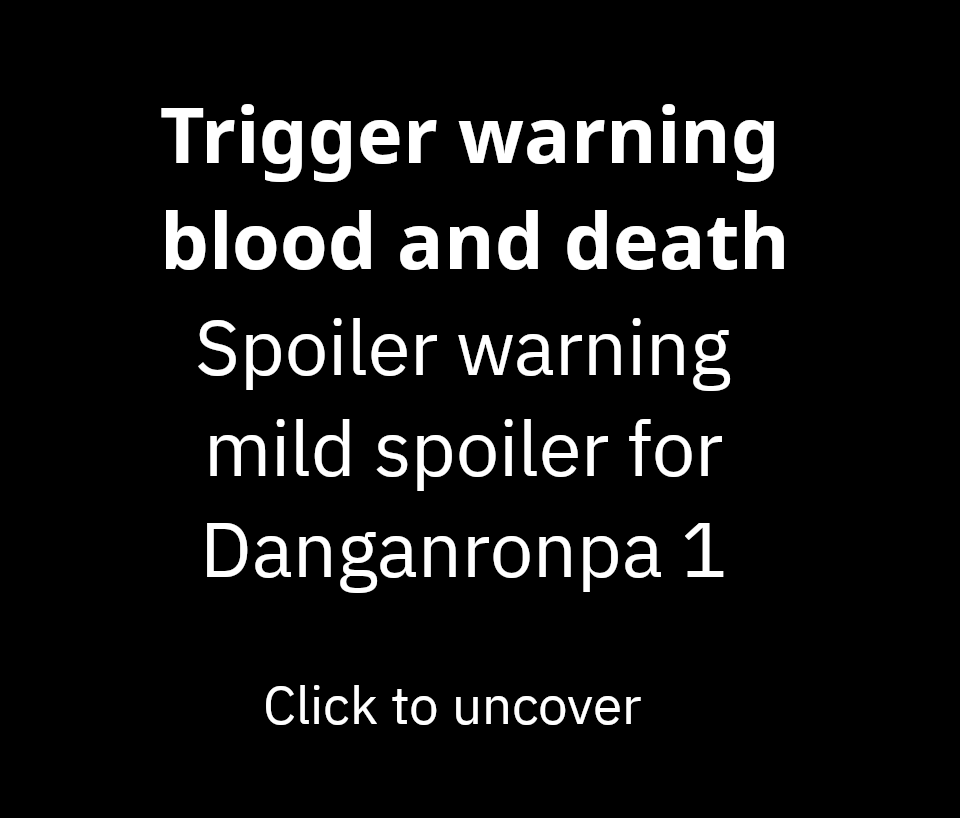
As such, Danganronpa, in my opinion, successfully visualizes the traumatizing environment of high school. By doing so, it can help readers better understand their own situation, and, in the case of the best-performed killing game, offer solutions for getting out of it. At worst, he'll provide some respite.
I often come across the notion that anime is just a mindless style of media that just portrays sexy women for horny men. Sure, there are pornographic animes. And yes, sexuality is an issue for anime. But are you surprised when the target audience for anime is just high school students? It's this group that's familiarizing themselves with their sexuality, and so it makes sense that they're watching media that can help them in some way. Maybe by holding up a mirror, or providing role models. As an example of anime actually trying to do this, I'm reminded of a well-known shounen anime named Bleach. In this work, the protagonist (with the aid of a giant sword) tries to infiltrate the mysterious Soul Society, where he wants recognition: an utter search for analogies of how adolescents try to infiltrate real society. I enclose a picture of the impressive gatekeepers of this Soul Society:

Not all killing games are teenage anime, so not all have the same themes as Danganronpa. I will try to summarise similar elements that the genre of killing games may have, and how they can serve as a critique of the contemporary society of neoliberal capitalism. If you have a problem with the notion of neoliberal capitalism, think of another: I refer simply to the state of our society today.
The unhealthy competition in the art world, for example, is evidenced by the Henry Chalupecki Prize, where one winner is traditionally chosen. But artists in recent years decided not to compete.
First, in each of them, by my definition, the protagonists murder each other, or are in some other way pitted against each other. It depends on the detail of each individual work, but I consider it a reflection of our contemporary society. In various aspects of it, we are forced to compete against each other: employment, romantic relationships, or art. This competition often takes on giant proportions: killing games are an even bigger pitch for her.
Another recurring theme in killing games is that the characters are aware of and work with the participation in the game. Sometimes he enters it voluntarily, as in Kaiji: Ultimate Survivor, when the protagonist, by participating in a bloody gambling, wants to clear his debts. Sometimes they are thrown into it against their will, as in Sword Art Online, where the protagonist plays a virtual reality game but can't opt out of it or he dies. And if he dies in the game, he dies in real life. Participants in the game are often confronted with a situation in which they themselves have to double-cross or even kill other people. It offers an interesting and dramatic conflict, where do I see a commentary on the current situation? For the most part, the protagonist is a perfectly normal person to empathize with. Killing someone doesn't come out of some perverse internal motive of his, it's forced by circumstances against which he resists as much as possible. Killing games send us a clear message: the fact that we currently suffer often and are pitted against others is not our fault, it is the system we are in that causes it. To fix this, it is not enough to change ourselves (and become more moral), we must change the system and stop the killing game.
Here we are on a bit of thin ice: most killing games are not explicitly anti-capitalist. There are no loud pleas breaking through the fourth wall urging us to seek out and dismantle the destructive systems in our lives. Often the wrecking system is personified by one game master you just have to kill, and the game ends, everyone is saved.
In my opinion, this ties in with the famous Live Bonfire, it is easier to imagine the end of the world than the end of capitalism. We see the current social reality as a given, or else: we do not see it. We're like fish in water wondering, hey, what's that water? A properly executed killing game should defeat exactly that feeling. The shock we get from seeing a lot of dead bodies can wake us up, can make us question why the tragedy happened, how it could have been avoided, and whether we see similar motives in the real world. Unfortunately, that almost never happens, especially recently. So let's look at why that might be?
Perhaps everyone has heard of the popular Netflix series Squid Game. The piece, which has been ten years in the making and has dominated the streaming platform charts since publication, is at first glance exactly as shocking as I've enumerated in the section above: we see a lot of murders here that scare us, they're caused by a system the players didn't choose, and the way out of the situation is to change that system. The series itself is explicitly anti-capitalist in that it directly themes debt and social inequalities. Still, I think his radical message missed the point.
For as the heyfomo site informs us, the protagonist of the Squid game has become an ambassador for the Gucci. Yes, the very brand that uses slave labor to produce its handbags and is the very emblem of what Squid Game (seemingly) criticizes. Next, for example, from a review refresher.cz, we learn that the series contains an annoying female, users on CSDF can't keep up the witty racist remarks, such as it's an uncompromising slant-eyed dodgeball and diverse psychoprobe, and the server idnes says it's the best servant of capitalism. There are certainly more serious reviews such as by Kamila Fila, but the nail on the head was struck by its caption idnes.
How can capitalism criticize the work that it has created, that directly benefits society from capitalism's most profitable? To be sure, in theory the Squid Game highlights the shortcomings of our society. But their critique echoes something like Marie Antoinette proposing to address famine by giving cakes to the poor. And that's a variant of admitting that we're even talking about a subversive work. Often, the very nature of the production - that the aim is to make as much money as possible rather than to create a good work - is erased by the interesting elements of Killing games, thus emptying the entire work. Various such examples will now be looked at. Head.
But first, a bit of terminology: the process by which a subversive message is altered to lose its subversiveness is called recuperation. One example of this might be the musical genre of punk: it used to be taken as a subversive genre, but today it will not make waves in the community. We'd be more surprised if some punk said something that went against the mainstream. Whether the subvertical messages are neutralized consciously or not, recovery is definitely happening. So I would like to map out exactly what mechanisms.
Indeed, the violence that occurs in killing games as a kind of bogeyman is effective. In the correct killing game, however, it always stands as an element that underlines the idea of the work. This does not happen in recuperated killing games, here we put violence at the centre and create a spectacle. A lot of anime goes down this path, allowing them to make themselves visible in a vast sea of competitors. Animation studios thus aim to create anime that is so stupid, so overblown, that people are intrigued. Also, there have been a lot of reaction channels on the YouTube, aimed at drawing attention to this group of content and publicly mocking them. One example is Mothers Channel
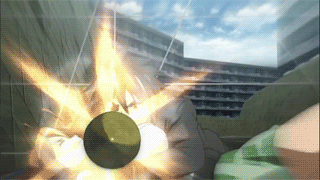
One problem with my analysis of the subgenre of killing games is that I'm working with a pretty vague definition, and I'm hitting it either too few guns or too many. The question is whether we can create this genre at all, if some elements of killing games haven't existed in the culture before, and maybe they've just been seen more often lately.
I append at the end a list of works that I consider to be killing games
Unfortunately, this fact isn't mapped in any detail, or I didn't find any killing games anthology in my research, so I can't give any definitive source. But to my knowledge, the subgenre of killing games was launched by the 1999 book Battle Royale or the 2000 film of the same name. Next came the gradual creation of anime in this genre, and sometime around 2015, this stream penetrated into video games, where the bag was ripped open with new titles.
The original Battle royale film, or works that more accurately fit into the killing games structure, does this with a purpose, and I find it stimulating. That is why it has become relatively popular. In my opinion, other titles that don't follow the formula as accurately have more of a slide on their popularity. They put the fight of all against all into the repertoire of tricks not because of a clear intention, but because they sensed that readers would like it.
A beautiful example of when the motive of everyone against all anime was used solely and exclusively by the studio to raise money without any regard for quality is Sword Art Online. It's an anime-filled fence of holes, kitsch and just plain bad writing, as reported by Mothers Basement
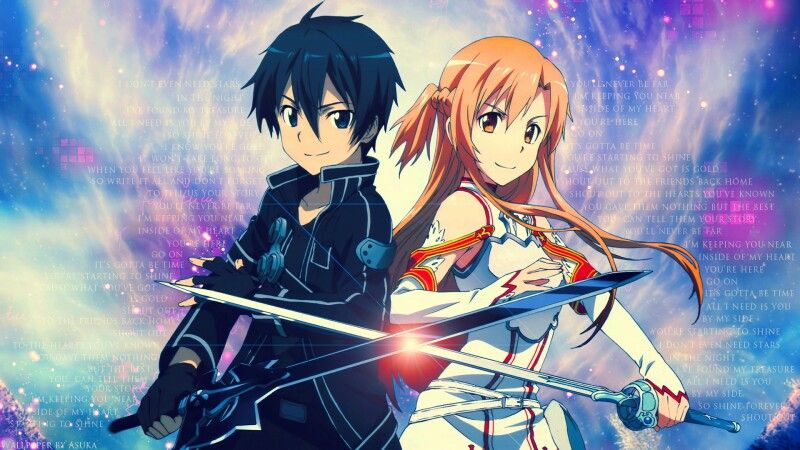
I don't have to explain that when the original idea is linearly mixed with other popular ideas for profit, meaning and meaning from the whole work begins to escape like air from a punctured mattress. I would rather briefly mention one very serious offence that the SAO is committing: the objectification of women. Kirito and love interest Asuna in the picture above make a great confident couple. But when we look at how their dynamics work up close, we see a large imbalance. For in all three series, they are only a kind of MacGuffin, a damsel in distress, for which the hero must surrender and graciously save her. Of course, he earns her hand and boundless gratitude, in fact, the girl is then bound to him.
The depiction of women as impotent objects that have no effect on the plot is simply wrong, made worse by the fact that this figure is often repeated. Worse still, however, is the thought that the rescued woman will fall in love with the rescuer immediately after her liberation, and be infinitely faithful and submissive to him. It's a gross oversimplification of real relationships, and it puts men in a superior position. When all this is supplemented over the period of the series by other women's deep cleavage, short skirts and monsters with tentacles, it's not just tasteless, it's a poor educational example for a lot of teens watching the show.
The culmination of toxic stereotypes about women can also be seen in Mirai Nikki's character Yuno Gasai (pictured below). In the beginning, she presents herself to the protagonist as loving and full of care, but in the end, her true side is revealed: she is a mentally ill psychopath who will do anything to spend even a moment with the main character. The depiction of women as highly emotional, unreasonable and annoying creatures going about their business is highly simplistic and makes me uncomfortable. But if only that were the case: Yuno fits squarely into the female-character archetype called yandere, which is more commonly found in anime and manga.
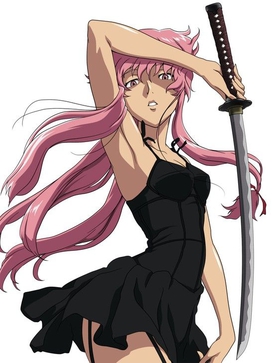
So, to recuperate killing games, amplify the violence appearing in them, mix with other, just-popular genres, and you're almost done. But one more common step is missing from the list: the removal of horror elements. But I do not mean taking away the violence of generally cruel things: that remains. Rather, it is a withdrawal of the psychological horror, the frightening atmosphere that exists among participants in killing games. It is this atmosphere that makes us think more about the story, because the fear of psychological horror can last far beyond the end of a movie or video game. And in a good case, it can make us think more about the story and look for hidden meanings.
For example, consider the games Fortnite or CS:GO. In Fortnite, we are in a child's colored world more like cartoons than anime, and it is because of the lightweight style that we do not even ask why we are forced to kill others. It doesn't really feel like murder to us either, because we can respawawright away and go into another game.
Fortnite is still an all-against-all competition, except all the gaming mechanisms are trying to convince us that there's nothing weird or dystopian about it. We get rewards for playing, and it doesn't really occur to us that we might spare others, because the game is simply set up so that the only mechanism for interacting with the rest of the world is shooting (and building materials). In the event that players deliberately lay down their arms, all but one of the contracting killing barriers will be killed. Violence here is in this way cast in the role of something natural, normalised. Similarly, CS:GO, here we are either casting ourselves in the role of terrorists (the T's) laying a bomb somewhere, or as counter terrorists (the C.T.'s) trying to prevent it. In short, both teams are trying to shoot each other.
Violence occupies the centre of our attention in CS:GO, only everyone (players and game characters) is completely apathetic towards it. Nobody thinks about the premise of the game, the only way to beat the TVs is to just give them a headshot. After all, players play alternately for both TVs and TVs, so it doesn't matter how it turns out. A bloody competition to scare the reader is on the other hand, with players competing against each other for days on end (grind\u00ed). There is a hierarchy based on how good people are, so-called ranks, and players can also buy cosmetic enhancements, so-called skins. A secondary market has even been created with skins, where players can speculate as if they were on the stock market. By playing CS:GO, we are thus entering a kind of capitalist microcosm: the exact opposite of the capitalist critique offered by the original genre.
We can count on the subgenre of killing games to survive in the public consciousness as a kind of zombie: it has influenced the popular or many popular games that people spend a lot of time on these days. The Squid Game series, which could bring him back to life, and breathe something original back into him, gave him momentary hope that we might see a rebirth. But when we take a closer look at the connection of this series to capitalism itself, we have to let go of all hopes that we have received a truly critical work. If the Squid Game had an impact, it was that it made possible the creation of the $456,000 Squid Game In Real Life! video, which is the re-creation of the series into a youtub video by the popular YouTuber Mr. Beast. This magnificent clickbait already had more views than the original work after a month or so, and we can actually take it as a wonderful example of Baudrillard's simulaker theory.
However, this does not mean that the subversive potential is already exhausted. I think the genre still offers a clear expression of the features of the system, allowing us to understand it better on an emotional level. But for the potential to be fulfilled, there would have to be some work outside the capitalist structures.
The advantage of working with a small subgenre is that I can keep tabs on a pretty substantial part of the market. That's why I'm listing here, for your convenience, all the killing games I could think of that I considered when writing.
Fortnite, Apex Legends, CS:GO, Among Us, Fall Guys, agar.io and other io games... (there are probably many more to be found here, I outlined the principal representative; it is true that this is a very loose interpretation of the subgenre: rather, games have borrowed the killing games element to increase popularity)
Battle Royale, Hunger games, Divergent